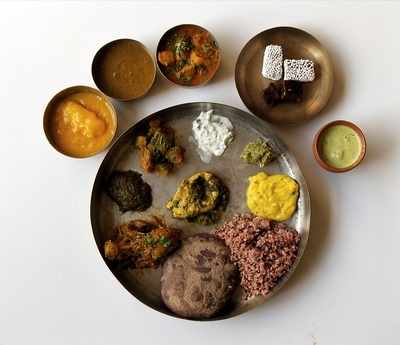Trending
This story is from March 6, 2020
India, on a thali!

Packed with varied flavours and textures, the great Indian thali promises to take you on an extraordinary culinary adventure
If there is one Indian dining experience that can rival any gourmet meal in the world, it's the "thali". "A multi-course meal that starts with the first sip of water proffered to an arriving guest, thali can continue into as lavish a spread of food as the host can afford, wind up with delectable desserts and conclude with a selection of mukhwas and paan, mouth fresheners and digestives eaten at the end of a meal," says Rushina Munshaw Ghildiyal, culinary chronicler and curator of food experiences.
India on a plate
The big, fat Indian thali reflects the country's love for food as well as cultural and culinary homogeneity. "Every region and state of India has a localised thali different from any other region but reflecting the same concept - having all flavours in one plate," says Maharaj Jodharam Choudhary. Think Punjabi thali, South Indian style thali, Rajasthani thal, Gujarati, Assamese, Bengali, Kutchi, Garhwali thalis and the list can go on. "All Indian thalis have a few common elements - seasonal and local ingredients and a display of popular indigenous techniques of cooking like boiling, frying, grilling on charcoal, kadhai cooking, slow cooking, banana-leaf steamed cooking etc. Common factors also include use of ghee for lending the richness and aroma to the food and usage of local oils like mustard, sesame, coconut, groundnut etc," says Chef Gautam Mehrishi.
There are many reasons and meanings behind the plating of the thali. "The history of the thali is more royal in nature. When thalis were served to families in royal households, everything was served once and no one could get up until everyone had finished their food. This way, thali inculcated meal-time discipline," says Choudhary. The thali also had elements of food for specific periods. "During war time, there was more protein to induce vigour, more subtle substances during peace times and more sweets and milk based products during festivities," says Mehrishi.
Traditionally, the lavish meal had to be eaten either clockwise or anti-clockwise depending on the region and culture of origin. This also decided the placement of food items in the thali. "A lot of emphasis was laid to plating to make sure the first and last dish created the desired impact in terms of taste and digestion process. For example, dahi must be eaten in the end as it support digestion by introducing probiotics," says Chef Milan Gupta.
In a way, the thali lays emphasis on portion control. "It is impossible to taste so many different flavourful delicacies unless served in limited quantities. A gigantic meal with limited portions of each flavour, thali is extremely satisfying. More importantly, you're not eating too much of anything, which works perfectly well for your body" adds Choudhary. Thus, the idea behind the thali is to essentially have a balanced meal, with all flavours as well as nutrients to keep you healthy.
While Indians have some incredible, interesting and innovative ways to present, enjoy and digest food, the emergence of a thali can be considered extraorinary revolution in Indian culinary history. Thali not only celebrates the diversity in Indian cuisine but also provides taste and nutrition. In fact, there are thali restaurants all over thr world today!
So, what's the secret to enjoying a hearty thali? Never count your calories.
Thali has acquired its name after the utensil it is served in - mainly a plate and many katoris (bowls). However, thali is neither a meal, nor a utensil. It is a tradition. Within the rim of that plate, abound many traditions handed down from one generation of Indian cooks to the next.
THALI HAS ITS ROOTS IN AYURVEDA
The Thali has roots in the famous Ayurveda Six Taste Theory that ensures meals are consumed in a way to balance the doshas, which regulate digestion, assimilation, and proper elimination. "Thali is said to be a complete representation of six tastes (sweet, sour, salty, pungent, bitter and astringent), which are essential for a balanced meal and a balanced body," says Chef Anurudh Khanna.
WISH TO HOST A THALI MEAL FOR YOUR GUESTS AT HOME? HERE ARE A FEW QUICK TIPS
1. The essential element is to create a balance of tastes and colours for a vibrant and rich thali. Depending on the occasion, the six predominant elements of a thali (dal, rice, vegetables, breads, yogurt and salad) would be augmented by an array of additional vegetables, chutneys, pickles, papads and sweet dishes.
2. For simple elegance, opt for a fresh banana leaf instead of a steel thali. The various colours of the contents beautifully stand out on a green leaf. Alternatively, pick a brass or steel thali.
3. Pay attention to small garnishes and tempering on individual dishes. It makes all the difference.
The opulence of thali may also be connected to historical displays of prosperity. The affluent would use it as a display of their wealth through the variety of dishes cooked and served in their kitchens. However, today, one can find a thali for every taste and budget.
If there is one Indian dining experience that can rival any gourmet meal in the world, it's the "thali". "A multi-course meal that starts with the first sip of water proffered to an arriving guest, thali can continue into as lavish a spread of food as the host can afford, wind up with delectable desserts and conclude with a selection of mukhwas and paan, mouth fresheners and digestives eaten at the end of a meal," says Rushina Munshaw Ghildiyal, culinary chronicler and curator of food experiences.
India on a plate
The big, fat Indian thali reflects the country's love for food as well as cultural and culinary homogeneity. "Every region and state of India has a localised thali different from any other region but reflecting the same concept - having all flavours in one plate," says Maharaj Jodharam Choudhary. Think Punjabi thali, South Indian style thali, Rajasthani thal, Gujarati, Assamese, Bengali, Kutchi, Garhwali thalis and the list can go on. "All Indian thalis have a few common elements - seasonal and local ingredients and a display of popular indigenous techniques of cooking like boiling, frying, grilling on charcoal, kadhai cooking, slow cooking, banana-leaf steamed cooking etc. Common factors also include use of ghee for lending the richness and aroma to the food and usage of local oils like mustard, sesame, coconut, groundnut etc," says Chef Gautam Mehrishi.
Eating it right
There are many reasons and meanings behind the plating of the thali. "The history of the thali is more royal in nature. When thalis were served to families in royal households, everything was served once and no one could get up until everyone had finished their food. This way, thali inculcated meal-time discipline," says Choudhary. The thali also had elements of food for specific periods. "During war time, there was more protein to induce vigour, more subtle substances during peace times and more sweets and milk based products during festivities," says Mehrishi.
Traditionally, the lavish meal had to be eaten either clockwise or anti-clockwise depending on the region and culture of origin. This also decided the placement of food items in the thali. "A lot of emphasis was laid to plating to make sure the first and last dish created the desired impact in terms of taste and digestion process. For example, dahi must be eaten in the end as it support digestion by introducing probiotics," says Chef Milan Gupta.
In a way, the thali lays emphasis on portion control. "It is impossible to taste so many different flavourful delicacies unless served in limited quantities. A gigantic meal with limited portions of each flavour, thali is extremely satisfying. More importantly, you're not eating too much of anything, which works perfectly well for your body" adds Choudhary. Thus, the idea behind the thali is to essentially have a balanced meal, with all flavours as well as nutrients to keep you healthy.
While Indians have some incredible, interesting and innovative ways to present, enjoy and digest food, the emergence of a thali can be considered extraorinary revolution in Indian culinary history. Thali not only celebrates the diversity in Indian cuisine but also provides taste and nutrition. In fact, there are thali restaurants all over thr world today!
So, what's the secret to enjoying a hearty thali? Never count your calories.
Thali has acquired its name after the utensil it is served in - mainly a plate and many katoris (bowls). However, thali is neither a meal, nor a utensil. It is a tradition. Within the rim of that plate, abound many traditions handed down from one generation of Indian cooks to the next.
- Rushina Munshaw Ghildiyal, culinary chronicler
THALI HAS ITS ROOTS IN AYURVEDA
The Thali has roots in the famous Ayurveda Six Taste Theory that ensures meals are consumed in a way to balance the doshas, which regulate digestion, assimilation, and proper elimination. "Thali is said to be a complete representation of six tastes (sweet, sour, salty, pungent, bitter and astringent), which are essential for a balanced meal and a balanced body," says Chef Anurudh Khanna.
WISH TO HOST A THALI MEAL FOR YOUR GUESTS AT HOME? HERE ARE A FEW QUICK TIPS
1. The essential element is to create a balance of tastes and colours for a vibrant and rich thali. Depending on the occasion, the six predominant elements of a thali (dal, rice, vegetables, breads, yogurt and salad) would be augmented by an array of additional vegetables, chutneys, pickles, papads and sweet dishes.
2. For simple elegance, opt for a fresh banana leaf instead of a steel thali. The various colours of the contents beautifully stand out on a green leaf. Alternatively, pick a brass or steel thali.
3. Pay attention to small garnishes and tempering on individual dishes. It makes all the difference.
DID YOU KNOW?
The opulence of thali may also be connected to historical displays of prosperity. The affluent would use it as a display of their wealth through the variety of dishes cooked and served in their kitchens. However, today, one can find a thali for every taste and budget.
End of Article
FOLLOW US ON SOCIAL MEDIA









